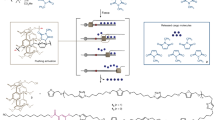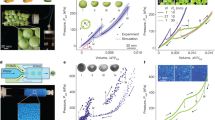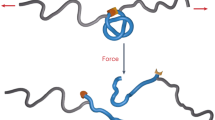Abstract
The mechanical properties of soft biological tissues are essential to their physiological function and cannot easily be duplicated by synthetic materials. Unlike simple polymer gels, many biological materials—including blood vessels1, mesentery tissue2, lung parenchyma3, cornea4 and blood clots5—stiffen as they are strained, thereby preventing large deformations that could threaten tissue integrity. The molecular structures and design principles responsible for this nonlinear elasticity are unknown. Here we report a molecular theory that accounts for strain-stiffening in a range of molecularly distinct gels formed from cytoskeletal and extracellular proteins and that reveals universal stress–strain relations at low to intermediate strains. The input to this theory is the force–extension curve for individual semi-flexible filaments and the assumptions that biological networks composed of these filaments are homogeneous, isotropic, and that they strain uniformly. This theory shows that systems of filamentous proteins arranged in an open crosslinked mesh invariably stiffen at low strains without requiring a specific architecture or multiple elements with different intrinsic stiffness.
This is a preview of subscription content, access via your institution
Access options
Subscribe to this journal
Receive 51 print issues and online access
$199.00 per year
only $3.90 per issue
Buy this article
- Purchase on Springer Link
- Instant access to full article PDF
Prices may be subject to local taxes which are calculated during checkout




Similar content being viewed by others
References
Shadwick, R. E. Mechanical design in arteries. J. Exp. Biol. 202, 3305–3313 (1999)
Fung, Y. A First Course in Continuum Mechanics (Prentice Hall, Englewood Cliffs, 1994)
Karakaplan, A. D., Bieniek, M. P. & Skalak, R. A mathematical model of lung parenchyma. J. Biomech. Eng. 102, 124–136 (1980)
Hjortdal, J. O. Extensibility of the normo-hydrated human cornea. Acta Ophthalmol. Scand. 73, 12–17 (1995)
Shah, J. V. & Janmey, P. A. Strain hardening of fibrin gels and plasma clots. Rheologica Acta 36, 262–268 (1997)
Janmey, P. A. et al. The mechanical properties of actin gels. Elastic modulus and filament motions. J. Biol. Chem. 269, 32503–32513 (1994)
Xu, J., Tseng, Y. & Wirtz, D. Strain hardening of actin filament networks. Regulation by the dynamic cross-linking protein alpha-actinin. J. Biol. Chem. 275, 35886–35892 (2000)
Ma, L., Xu, J., Coulombe, P. A. & Wirtz, D. Keratin filament suspensions show unique micromechanical properties. J. Biol. Chem. 274, 19145–19151 (1999)
Fixman, M. & Kovac, J. Polymer conformational statistics. III. Modified Gaussian models of stiff chains. J. Chem. Phys. 58, 1564–1568 (1973)
Smith, S. B., Finzi, L. & Bustamante, C. Direct mechanical measurement of the elasticity of single DNA molecules by using magnetic beads. Science 258, 1122–1126 (1992)
Marko, J. & Siggia, E. Stretching DNA. Macromolecules 28, 8759–8770 (1995)
MacKintosh, F., Käs, J. & Janmey, P. Elasticity of semiflexible biopolymer networks. Phys. Rev. Lett. 75, 4425–4428 (1995)
Kroy, K. & Frey, E. Force-extension relation and plateau modulus for wormlike chains. Phys. Rev. Lett. 77, 306–309 (1996)
Morse, D. Viscoelasticity of tightly entangled solutions of semiflexible polymers. Phys. Rev. E 58, R1237–R1240 (1998)
Gittes, F. & MacKintosh, F. C. Dynamic shear modulus of a semiflexible polymer network. Phys. Rev. E 58, R1241–R1244 (1998)
Treloar, L. R. G. The Physics of Rubber Elasticity (Clarendon, Oxford, 1975)
Landau, L. D. & Lifshitz, E. M. Statistical Physics I (Pergamon, Oxford, 1980)
Landau, L. D. & Lifshitz, E. M. Theory of Elasticity (Pergamon, Oxford, 1986)
Gittes, F., Mickey, B., Nettleton, J. & Howard, J. Flexural rigidity of microtubules and actin filaments measured from thermal fluctuations in shape. J. Cell Biol. 120, 923–934 (1993)
Head, D. A., Levine, A. J. & MacKintosh, F. C. Deformation of cross-linked semiflexible polymer networks. Phys. Rev. Lett. 91, 108102 (2003)
Wilhelm, J. & Frey, E. Elasticity of stiff polymer networks. Phys. Rev. Lett. 91, 108103 (2003)
Gardel, M. L. et al. Elastic behavior of cross-linked and bundled actin networks. Science 304, 1301–1305 (2004)
Grosberg, A. Y. & Khlokhlov, A. R. Statistical Physics of Macromolecules (American Institute of Physics Press, New York, 1994)
Wilhelm, J. & Frey, E. Radial distribution function of semiflexible polymers. Phys. Rev. Lett. 77, 2581–2584 (1996)
Leterrier, J. F., Kas, J., Hartwig, J., Vegners, R. & Janmey, P. A. Mechanical effects of neurofilament cross-bridges. Modulation by phosphorylation, lipids, and interactions with F-actin. J. Biol. Chem. 271, 15687–15694 (1996)
Janmey, P. A. & Ferry, J. D. Gel formation by fibrin oligomers without addition of monomers. Biopolymers 25, 1337–1344 (1986)
Janmey, P. A., Hvidt, S., Lamb, J. & Stossel, T. P. Resemblance of actin-binding protein/actin gels to covalently crosslinked networks. Nature 345, 89–92 (1990)
Janmey, P. A., Euteneuer, U., Traub, P. & Schliwa, M. Viscoelastic properties of vimentin compared with other filamentous biopolymer networks. J. Cell Biol. 113, 155–160 (1991)
Wang, L. Z. et al. Purification of salmon clotting factors and their use as tissue sealants. Thromb. Res. 100, 537–548 (2000)
Acknowledgements
We are grateful to J.-F. Leterrier, S. Hvidt, P. Traub, J. Hartwig and E. Sawyer for collaboration in producing the protein networks and electron micrographs. This work was supported in part by the US-NIH and NSF/MRSEC programmes (P.A.J., T.C.L., C.S., J.J.P.) and by the Kavli Institute for Theoretical Physics at the University of California (F.C.M., P.A.J.), where some of this work was initiated.
Author information
Authors and Affiliations
Corresponding author
Ethics declarations
Competing interests
The authors declare that they have no competing financial interests.
Rights and permissions
About this article
Cite this article
Storm, C., Pastore, J., MacKintosh, F. et al. Nonlinear elasticity in biological gels. Nature 435, 191–194 (2005). https://doi.org/10.1038/nature03521
Received:
Accepted:
Issue Date:
DOI: https://doi.org/10.1038/nature03521
This article is cited by
-
Field Guide to Traction Force Microscopy
Cellular and Molecular Bioengineering (2024)
-
Extracellular vesicle–matrix interactions
Nature Reviews Materials (2023)
-
Predicting cancer stages from tissue energy dissipation
Scientific Reports (2023)
-
Combined computational modeling and experimental study of the biomechanical mechanisms of platelet-driven contraction of fibrin clots
Communications Biology (2023)
-
Hydration solids
Nature (2023)
Comments
By submitting a comment you agree to abide by our Terms and Community Guidelines. If you find something abusive or that does not comply with our terms or guidelines please flag it as inappropriate.



